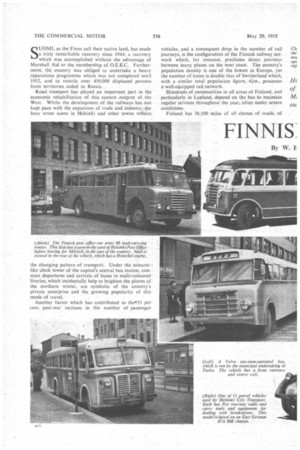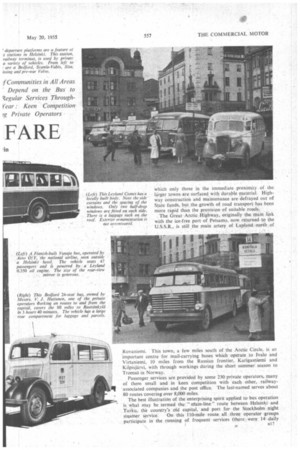FINNIS FARE
Page 42

Page 43

Page 44

If you've noticed an error in this article please click here to report it so we can fix it.
By W. F
in
SUOMI, as the Finns call their native land, has made a truly remarkable recovery since 1944; a recovery which was accomplished without the advantage of Marshall Aid or the membership of 0.E.E.C. Furthermore, the country was obliged to undertake a heavy reparations programme which was not completed until 1952, and to resettle over 450.000 displaced persons
from territories ceded to Russia. . .
Road transport has played an important part in the economic rehabilitation of this eastern .outpost of the West. Whilst the development of the railways has not kept pace with the expansion of trade and industry, the busy street scene in Helsinki and other towns reflects
the changing pattern -of transport. Under the minaretlike clock tower of the capital's central bus station, Con stint departures and arrivals of buses in multi-coloured ' liveries, which incidentally help to brighten the gloom of " the northern winter, are symbolic of the country's private enterprise and the growing popularity of this mode of travel.
Another factor which has contributed to the+33 per cent, post-war increase in the number of passenger vehicles, and a consequent drop in the number of rail journeys, is the configuration of the Finnish railway network which, for instance, precludes direct journeys between many places on the west coast. The country's population density is one of the lowest in Europe, yet the number of buses is double that of Switzerland which, with a similar total population figure, 4i-in., possesses a well-equipped rail network.
Hundreds of communities in all areas of Finland, and particularly in Lapland, depend on the bus to maintain regular services throughout the year, often under severe conditions.
Finland has 36,100 miles of all classes of roads. of
which only those in the immediate proximity of the larger towns are surfaced. with durable material. Highway construction and maintenance are defrayed out of State funds, but the growth of road transport -has been more rapid than the provision of suitable roads.
The Great Arctic Highway, originally the main link with the ice-free port of Petsamo, now returned to the U.S.S.R.. is still the main artery of Lapland north. of .Rovaniemi. This town, a few miles south of the Arctic Circle, is an important centre for mail-carrying buses which operate to Ivalo and Virtaniemi, 10 miles from the Russian frontier, Karigasniemi and Kilpisjarvi, with through workings during the short summer season to Tromso in Norway. •
Passenger services are provided by some 230 private operators, many of them small and in keen competition with each other, railway14 'associated companies and the post office. The last-named serves about 80 routes covering over 8,000 miles.
The best illustration of the enterprising spirit applied to bus operation is what may be :termed the " ntain-line " route between Helsinki and . Turku, the country's old capital. and port for the Stockholm night
steamer service. On this 110-mile route all three operator groups participate in the running of frequent services (there were 14daily
departures last year) which are actually cheaper and faster than the railway. Trains travel through the Russian-occupied Porkkala zone and undergo a cumber _some, time-consuming " blacking-out-of-windows " routine while the 31-hour bus service by-passes this area at a fare equivalent to 9s. 6d,
Roads Determine Fares Although fares are generally low they are graded according to the type of road traversed, and an operator on a second-class country road will charge slightly more than for a similar mileage on a first-class Finnish highway. Weight restrictions on all roads outside towns limit the types of vehicle which can be used on crosscountry, services. Large numbers of. Leyland Comet buses are in use, both in the normal-control and forward-control versions.
Before the war, Finland imported vehicles and chassis mainly from the United States, Sweden and Germany. Since the war the lack of dollars has kept down American imports and Britain has come strongly into the market. British passenger chassis (complete buses are not imported) and engines have within a few years attained a high reputation for hard-wearing quality and reliability, but unfortunately this favourable position is threatened by reciprocal trade agreements with East Germany and Iron Curtain countries which otherwise could not possibly hope to be competitive in this sphere.
Bringing Costs Down Two Finnish factories are engaged in the construction of goods vehicles and buses from proprietary parts and components, and there is an assembly plant of a Swedish manufacturer. All bus bodies are of Finnish make and every effort is being made to bring production costs down. Much obsolete plant and equipment is now being replaced and more efficient methods are being introduced.
The total number of buses and coaches is 4,250, of which over 240 are being operated by Helsinki City Transport. This article cannot conclude without briefly noting some of the features of the capital's municipal transport system. Apart from 34 routes which are served by oil-engined buses, there is also one route which is equipped for trolleybus operation; for which purpose 23 vehicles are available. These werebuilt by Valmet of Tampere, the country's industrial centre, , which is theonly other Finnish city to, operate trolleybuses. .
Helsinki has a large tramway system, but bus traffic
B18-
has shown a five-fold increase between 1946 and 1953, when 53,667,000 passengers were carried The buses are painted a different colour from the trams, and yet another distinctive colour is to be used when one-man operation is introduced on certain 'routes shortly. The fleet, which includes 33 Leyland Royal Tiger buses, also comprises Scan ia-Vabis and some pre-war Bussing vehicles.
Because of road conditions, at the beginning and end of the winter season, severe difficulties are often experi-' enced in maintaining services. Many routes are over roads with bad surfaces which ice damages even more and lyre wear is particularly high.* An efficient breakdown organization, with Pye radio-telephone service vans and a half-track vehicle ambulance, has been built up and operates from the new main road and tram depot at Koskela. This was opened 18 months ago and is one of the most up to date of its kind in Europe.
Assembly-line Service
Here assembly-line principles have been applied to 'the servicing and routine maintenance of vehicles. Each bus, on returning to the depot and after refuelling, is taken down the service line by a conveyor-belt system. After passing through an automatic washing plant, the driver leaves the bus, which is then attached to an underground chain.
This is timed to move at fixed intervals, each of which provides sufficient time for the necessary service provided by that particular section. Up to six buses can be on the conveyor simultaneously, although 10 air-conditioned repair pits are also available for maintenance after long mileages and special work, such as brake testing and engine changes. Traffic offices, a canteen and staff rooms are of the most modern design. Admirably fulfilling its purpose, the unusual methods dictated to a certain extent by climatic conditions, the new depot is characteristic of the way Finland tackles its transport.




















































































